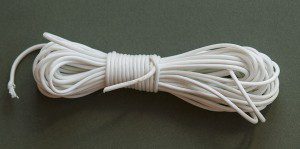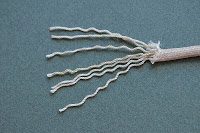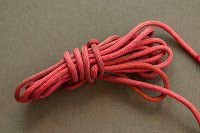Among the many survival tips I have learned from Peter Kummerfeldt is to always carry paracord as part of my emergency gear. I have used it for everything imaginable, and you will too!
by Peter Kummerfeldt |
| 550 cord, paraline, paracord, parachute line, call it what you will, 150 feet of mil-spec parachute line should be a part of your gear. (Peter Kummerfeldt photos) |
As I think back over nearly 46 years of teaching survival skills and about the same amount of time beating about the bush, I don't think I have ever been without some parachute cord. I have used to to build shelters, catch fish, weave nets, make stronger rope, for emergency dental floss, as sewing thread, to retrieve water when I was cliff-bound and yes, parachute line has lowered me to the ground when I jumped out of an airplane while I was in the Air Force. Simply put it can truly be a life saver!
 |
| Paracord is made of several nylon fibers, which gives it a strong tensile strength. |
What is parachute line? Parachute line is made up of a tubular case containing seven pieces of thinner, nylon threads each of which can be further separated into three even finer threads.
 |
| Each fiber has about 35 pounds of strength. |
 |
| Make sure you can see your paracord. |
I recommend buying white cord and then dying it bright red or orange so that you can find it if you drop the line on the ground or worse still, on snow.
RIT fabric dye works well. Make a concentrated solution and then drop your parachute line into it and leave it there until you are happy with the color. Before you remove it from the dye pour in a cup of vinegar to set the dye and let it sit some more - a couple of days. If you don't do this, since nylon doesn't take up dye very well, the dye will come off in your hands.
Stronger rope can be made from parachute line by either twisting two ropes together or by braiding three or more pieces together.
As I said in the beginning, 150 feet in 25 foot lengths, should be included in your gear. There's no way to improvise a line from natural resources that comes close to the strength, utility and usefulness of parachute line. Check out this paracord.
Peter Kummerfeldt has walked the talk in the wilderness survival field for decades.
Peter grew up in Kenya, East Africa and came to America in 1965 and joined the U.S. Air Force. He is a graduate of the Air Force Survival Instructor Training School and has served as an instructor at the Basic Survival School, Spokane, Washington; the Arctic Survival School, Fairbanks, Alaska, and the Jungle Survival School, Republic of the Philippines.
 |
| Peter Kummerfeldt |
For twelve years, Peter was the Survival Training Director at the United States Air Force Academy, Colorado Springs, Colorado. He retired from the Air Force in 1995 after 30 years of service.
In 1992, concerned with the number of accidents that were occurring in the outdoors annually and the number of tourists traveling overseas who were involved in unpleasant and sometimes life-threatening incidents Peter created
He is the author of “Surviving a Wilderness Emergency” and has addressed over 20,000 people as the featured speaker at numerous seminars, conferences and national conventions.
Check out Peter’s blog at: OutdoorSafe.blogspot.com

No comments:
Post a Comment